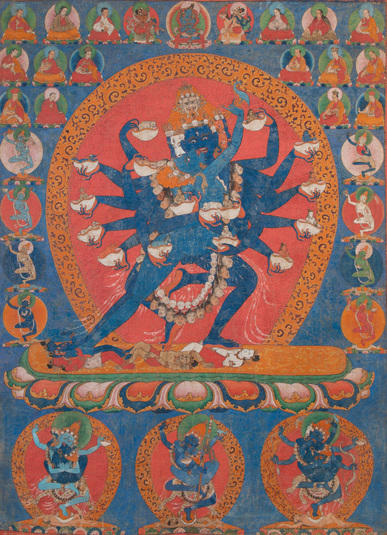
Item: Hevajra (Buddhist Deity) - (Hevajra Tantra)
| Origin Location | Tibet |
|---|---|
| Date Range | 1600 - 1699 |
| Lineages | Karma (Kagyu) and Buddhist |
| Material | Ground Mineral Pigment on Cotton |
| Collection | Private |
Hevajra and Nairatmya according to the lineage of Ngogton Choku Dorje (1036-1097 [PORK1289]) of the Marpa Kagyu Tradition. From Ngogton's descendants branches of the lineage went into other Kagyu traditions such as the Karma Kagyu as evidenced in this composition with the appearance of three Karmapas and a Shamarpa. (See HAR #61401).
"...Shri Hevajra with a body blue in colour, eight faces, sixteen hands and four legs. The main face is blue, right white, left red, upper face smoky; the two remaining pairs of faces are black. Each face has three eyes and four bared fangs; yellow hair flowing upwards; the top of the head is marked with a vishvavajra. The sixteen hands hold sixteen skullcups. The first right holds a white elephant, the first left holds the yellow God of Earth; these two embrace the Mother. In the second right is a blue horse; third - ass with a white patch; fourth - yellow bull; fifth - ash-coloured camel; sixth - red man; seventh - blue sharabha; eighth - cat with a white patch. In the second left hand is the white God of Water; third - red God of Fire; fourth - green God of Air; fifth - white God of the Moon; sixth - red God of the Sun; seventh - blue Yama; eighth - yellow Holder of Wealth. Each head has a crown of five dry human skulls; and a necklace of fifty fresh heads; six bone ornaments; the two right legs are extended, on the thighs the toes of the two folded left legs are pressing in the half-[vajra] posture in a dancing manner; possessing the nine sentiments of dancing: grace, strength and ugliness; laughter, ferocity and frightful; compassion, fury and peace. In the lap is the mother Vajra Nairatmya, with a body blue in colour, one face, two hands, three eyes; yellow hair flowing upwards; right a curved knife, left holding a skullcup and embracing the father; five dry human skulls as a crown; a necklace of fifty dry [skulls]; five bone ornaments; left leg extended and the right drawn up embracing the father. Both are standing in the middle of a blazing fire of pristine awareness." (Ngagwang Legpa).
This form of Hevajra has the two right legs extended and the two left legs bent standing atop the four gods, Brahma, Indra, Vishnu and Shiva.
Descending on the right and left sides of the central figure are the Eight Goddesses.
"...in the east black Gauri, right hand holding a curved knife, left a rohita fish; south red Chauri, right hand holding a damaru, left a pig; west yellow Vetali, right hand holding a tortoise, left a skullcup; north green Ghashmari, right hand holding a snake, left a skullcup; north-east blue Pukkashi, right hand holding a lion, left an axe; south-east white Shavari, right hand holding a monk, left a monk's staff; south-west purple Chandali, right hand holding a wheel, left a plough; north-west multi-coloured Dombini, right hand holding a vajra, left a wrathful gesture. Also, all have one face, two hands, three eyes and yellow hair flowing upward; naked, adorned with five ornaments of bone; a crown of five human skulls and a necklace of fifty skulls. With the left leg extended and the right in a half-lotus posture, in a dancing manner, they stand in the middle of a blazing fire of pristine awareness." (Konchog Lhundrub).
At the bottom of the composition there are three forms of Hevajra. At the center with two arms is 'Body' Hevajra. On the left side with four arms is 'Speech' Hevajra embracing the consort Vajravarahi. On the right side with six arms is 'Mind' Hevajra embracing the consort Vajra Shringkhala. In some traditions the 'Body' Hevajra embraces the consort Vajta Nairatmya while in other traditions he is called the 'Solitary Hero' and does not have a consort.
Lineage of Teachers : Vajradhara, Jnana Dakini, Bodhisattva Vajragarbha, Arya Nagarjuna, Aryadeva, Chandrakirti, Matangipa, Telo Prajnabhadra, Naro Jnana Siddhi, Marpa Lotsawa Chokyi Lodro (1002/12-1097/1100 [P2636]), Ngog Choku Dorje, Ngog Shedang Dorje, Ngog Sengge Dra, Ngog Kunga Dorje, Ngog Zije Dragpa, Ngog Rinchen Zangpo, Ngog Chokyi Gyaltsen, Ngog Sanggye Yonten, Ngog Dondrub Palzang, Ngog Jangchub Pal, Drukhang Lotsawa Sonam Gyatso, Shamar 4th Chennga Chodrag (1453-1524 [P317]), etc. (rgyud sde kun btus volume 30, folio 165, and folio 142 & 143 for the Mahamaya lineage).
Jeff Watt 2-2016
Collection: Kapoor Galleries
Collection: Christies New York, March, 2023 (Painting)
Painting Tradition: Khyenri Main Page
Buddhist Deity: Hevajra Main Page
Collection of Anna Maria Rossi & Fabio Rossi
Painting Style: Khyenri (Karma Kagyu)
Buddhist Deity: Hevajra (Khyenri Style) Page
Buddhist Deity: Hevajra (Best Examples, Painting)
